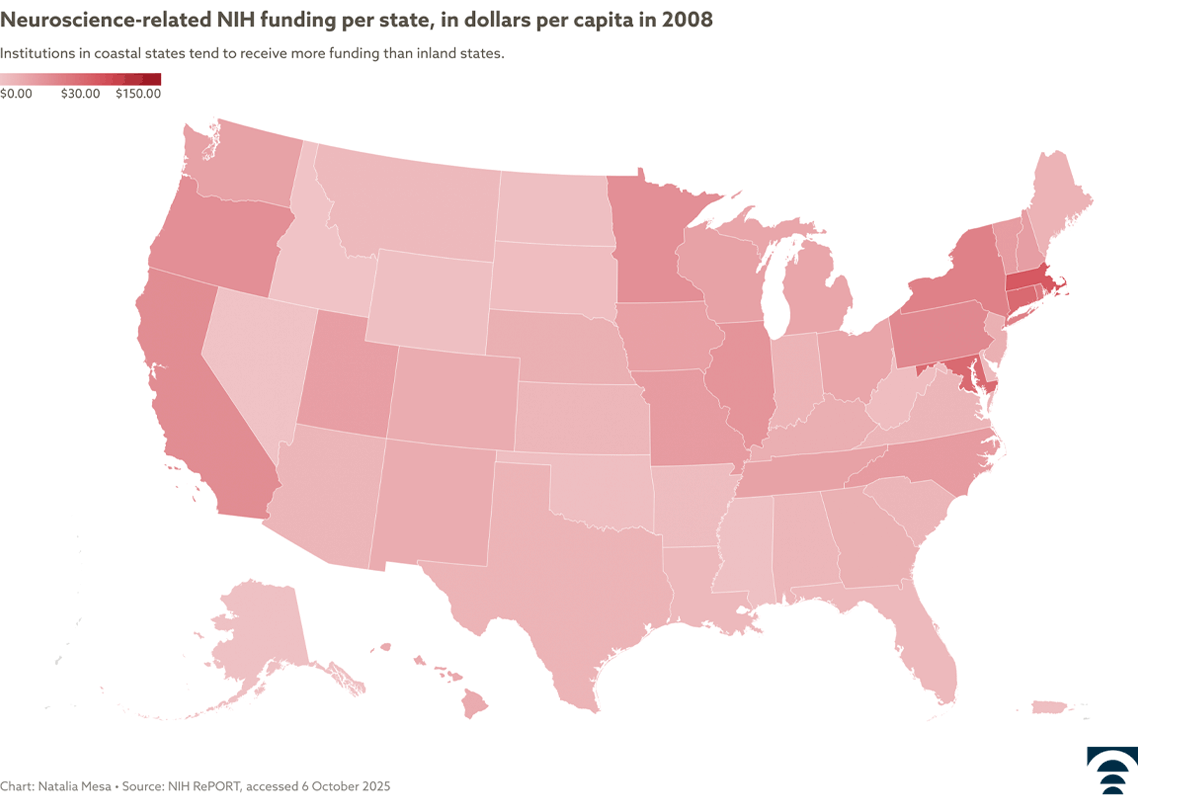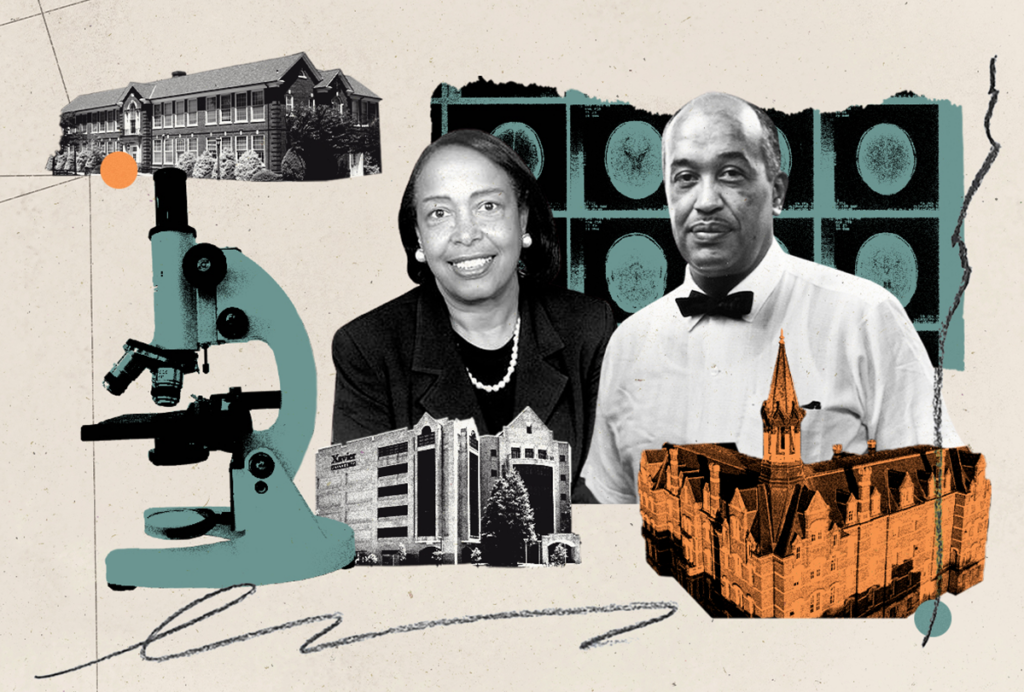In particular, we tracked neuroscience funding from the National Institutes of Health (NIH) using publicly available data from RePORT, the NIH’s funding database. The analysis included all grants administered by any of the agency’s institutes and centers in the neuroscience category, as determined by the NIH’s Research, Condition, and Disease Categorization (RCDC) system. Many funding sources for neuroscience research—both public and private—exist, but grants through the National Institute on Aging, the National Institute of Neurological Disorders and Stroke, and the National Institute of Mental Health, along with other NIH centers and institutes, make up a significant portion, according to NIH RePORT data.
Our analysis shows that the total amount awarded from the NIH for neuroscience projects more than doubled between 2008 and 2024, the latest year for which data are publicly available, jumping from $4.2 billion to $10.5 billion and increasing from 17.3 percent to 28.4 percent of the total sum of the agency’s extramural grants. But while the NIH made robust investments in neuroscience-related research in both the private and public sector during this period, minority-serving institutions—particularly historically Black colleges and universities (HBCUs)—consistently received smaller awards, on average, than other colleges and universities.
Here are some other key takeaways:
A shift toward large-scale research projects powered the steep rise in NIH neuroscience funding.
Changes in the NIH’s research priorities fueled its rapid funding growth, says Alessandra Zimmermann, project director of research and development policy at the American Association for the Advancement of Science, a nonprofit scientific society based in Washington, D.C. In 2004, the NIH established the NIH Blueprint for Neuroscience Research, an initiative among some of the NIH’s centers to foster collaboration and support large-scale neuroscience-related projects. Nine years later, in 2013, the group launched the Brain Research Through Advancing Innovative Neurotechnologies (BRAIN) Initiative, which has since funded more than 1,500 research projects. The BRAIN Initiative’s budget grew from $100 million at launch to roughly $680 million in 2023, though it dropped to $321 million in 2025.
The growing burden of neurological disease in the United States has also likely driven the uptick in neuroscience funding from the NIH, says Robert Roskoski, scientific director and president of the Blue Ridge Institute for Medical Research. His research has found that there was a 178 percent increase in National Institute on Aging funding for medical schools between 2011 and 2020. “It’s appropriate, because as a country, we’re getting older.”
Most funding goes to public medical schools, but private universities tend to get larger grants.
The NIH primarily funds neuroscience projects at universities, which received roughly 80 percent of the total awarded funds between 2008 and 2024. University medical schools tend to receive more funding and larger grants than schools of arts and sciences, public health or engineering, largely because of the NIH’s focus on biomedical research, Roskoski says.
Although public universities received a larger share of all neuroscience funding than private universities, larger individual awards, on average, went to private universities and other private research centers and companies during this period. Roskoski speculates that this pattern is driven mainly by private universities with large endowments, which typically have a strong research infrastructure and can attract and retain top talent. “It just goes back to the quality of the faculty and the principal investigators,” he says.
In line with this idea, studies have shown that institutions with high levels of NIH funding tend to produce and recruit the most recipients of early-career research project grants.
Coastal mainland states in the U.S. got more funding than inland ones did, with Alaska, Hawaii and Puerto Rico seeing the smallest increases in funding.
East Coast and West Coast states in the mainland U.S. received larger total increases in neuroscience-related NIH funding over time than inland states did, with Massachusetts experiencing the largest per capita increases between 2008 and 2024, followed by Maryland, Connecticut and Rhode Island. Massachusetts, already the highest-funded state in 2008, received more than double the amount of funding per capita compared with Maryland in 2024. Meanwhile, Puerto Rico, South Dakota and Alaska saw the smallest per capita funding increases between 2008 and 2024, while Hawaii experienced a substantial decrease in funding. Again, Roskoski says, the majority of NIH funding is likely going to states that have the largest research infrastructure.
Minority-serving institutions, particularly HBCUs, tend to receive smaller grants, on average, than private and public universities.
“This doesn’t at all surprise me,” says Marybeth Gasman, professor of education at Rutgers University, who studies funding equity. Several studies have documented similar trends for private, state and federal grants across science overall and show that Black scientists applying for NIH grants consistently receive lower scores as a result of bias during the peer-review process—something the NIH openly acknowledges. “Across the board in terms of private funding, public funding, all throughout history, HBCUs are always given less,” Gasman says.
The same is true for other minority-serving institutions, including those that serve Indigenous communities, Hispanic populations, and Asian American and Native American Pacific Islanders, Gasman adds. “Tribal colleges get basically no funding.”
However, there are likely other factors driving these disparities, Gasman says. Relatively few minority-serving institutions, particularly HBCUs, are research-focused universities: Only four HBCUs have medical schools, and only one—Howard University—is currently classified as an R1 institution, meaning it has “very high research spending and doctorate production,” according to the Carnegie Classification of Institutions of Higher Education. Only 13 HBCUs and about 30 Hispanic-serving institutions have an R2 classification, which indicates slightly lower research activity than R1 institutions.
The NIH has taken steps to address these disparities in the past few years. For instance, in 2021 it established the Support for Research Excellence (SuRE) program, which funds scientific research and training initiatives at HBCUs and other minority-serving institutions. According to Grants.gov, a notice of funding opportunity for SuRE grants was posted on 13 June, indicating that the program is still open. Earlier this year, however, the NIH terminated several other training programs, many of which support scientists from underrepresented communities.
The NIH Office of Extramural Research, the National Institute of Mental Health and the National Institute of Neurological Disorders and Stroke declined to comment on the status of NIH funding for minority-serving institutions.







